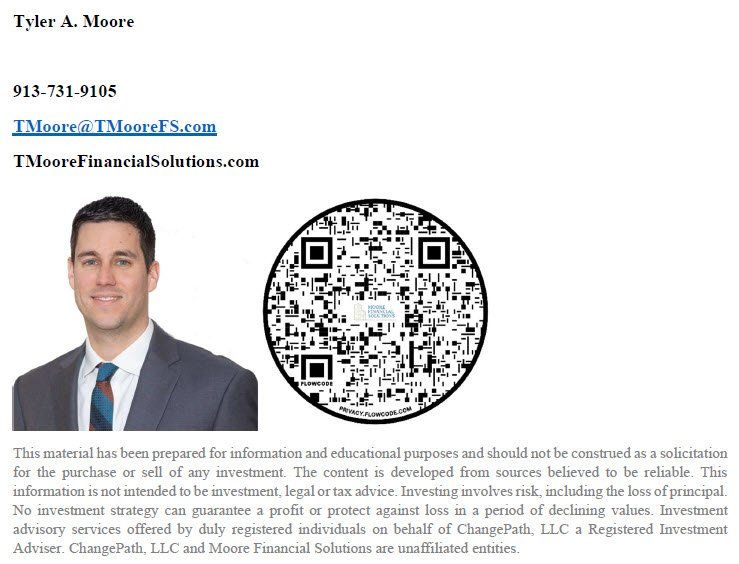The third quarter of 2021 looked as if it was on pace for another profitable period, when instead, it
began to move lower. The S&P 500 started the quarter at 4,297.50 (the June 30th closing price) and reached a high of 4,545.85 (within the September 2nd trading day). This rise of 5.78% seemed to forecast another quarter providing exponential strength within United States Equities. However, the quarter only provided a point gain of .23% as it closed September 30th at 4,307.54. The S&P 500 pays a dividend which increases the total return to shareholders above .23%. Moore Financial Solutions uses the S&P 500 as a conversational benchmark for investors’ United States equity exposure and is not referencing a specific managed portfolio. This quarterly report will discuss increasing interest rates, inflation/supply
chain issues, Covid-19, Fed Policy/Taxation, Debt Ceiling, and the Moore F.S. “buy and hold” method to equity investing.
Coincidentally, interest rates took a similar path of increasing within the quarter before coming back down to end the quarter up just slightly. The United States 10-year treasury started the quarter with a 1.469% yield, rose to 1.541% on September 28th and closed the quarter at 1.487%. As interest rates rise, the price of existing bonds will likely decline. While the interest paid on bonds will eventually increase as interest rates go up, many bond investors would be satisfied with this happening gradually. Interest rates increased as Jerome Powell no longer maintained that a tapering of the Fed’s asset purchasing wasn’t on the horizon. Instead, the Fed signaled that a tapering of its asset purchasing program could be happening shortly. Moore F.S. is not surprised by this news as we mentioned in our last quarterly review that this tapering was likely going to be coming in near future Fed meetings. Additionally, Moore F.S. has made a slight tilt to lower duration fixed income tools, while still favoring high credit quality exposure. We believe bonds compliment a portfolio of stocks for our clients who are unable to solely invest in equities, despite having a limited yield and the potential to decline during rising interest rates.
In our Q1 review, we predicted inflation becoming a headwind to companies. As predicted, most companies reported higher costs within the quarter through increased labor costs and/or increased cost of goods. This became further complicated by global supply chain issues and the inability for companies to get much needed products. Last quarter, we referenced the chip shortage for automakers as an
example of this pandemic related constraint. We continue to believe the companies that are maneuverable and flexible will carve a path through these problems. Moore F.S. feels that inflation and supply issues are the main foreseeable threats to American companies, and thus, their share prices.
United States markets kept a close eye on Covid-19 variants, especially the Delta Variant. In this quarter, we have moved from a position of uncertainty surrounding the Delta Variant to increased optimism that we could soon be seeing a Covid-19 antiviral pill, offered by Merck. This news was released on October 1st, 2021. Additionally, some have provided input that the Delta Variant might be the “final wave” of the Covid-19 pandemic. Many businesses reported the Delta Variant impacting their sales and customer flow less impactfully than they had initially forecasted. We remain cautiously optimistic, though uncertain, on the path of Covid-19.
As mentioned, Jerome Powell stated that a tapering of asset purchases is on the horizon. This will reduce easing monetary policy and likely will increase rates somewhat. Companies slightly lose the benefit of cheap money to fund operations when this interest rate increase happens. We believe the interest rate increases have surprised very few, and most have adequately priced this in. Further policy
change conversation surrounding increases in taxes on dividends and capital gains hit equity markets in Q3. It seems the market has digested this information and the potential of these changes are now priced in. Some selling of equities happened when this news began to form. This could potentially be from investors wanting to sell appreciated equity positions at the current capital gains tax level before increases happen or simply due to pricing in a somewhat less favorable opportunity for new money in equities. Moore F.S. understands that changes like this are typically retroactive, potentially because, when the news came out it was already essentially enacted. We believe that this demonstrates the value of the strategy of buying and holding equities, especially in non-retirement/taxable accounts.
Q3 of 2021 marches toward the “Debt Ceiling”, leaving many questions about the future outcome. The “Debt Ceiling” represents the maximum amount of debt the United States Federal Government can have outstanding. Currently, the debt ceiling is set at 28.4 trillion dollars. The results of votes on raising the debt ceiling will likely move markets in the short term. The U.S. faced, and resolved, this problem in 2011, 2013 and 2019, allowing equity markets to aggressively march higher. Moore F.S. believes situations surrounding short-term voting to raise the debt ceiling, or miss payments, is an example of a United States stock market speed bump. This means a pullback in equity prices in the short-term, despite the long-term trajectory of equities historically pointing upward. Some economists would offer that a growing national debt is tolerable if we have a growing gross domestic product. Moore F.S. finds concern with the amount of our spending directly going to pay interest on our debts. In 2019, $375 billion went towards paying interest on our debts. This $1B+ daily cost represented 8.4% of all U.S. federal budget for that year. Moore F.S. remains unimpressed with the trajectory of the amount of U.S. obligations outstanding. U.S. government debt instruments are owned commonly in the form of bills, notes, and bonds in short to long time horizon. Examples of government debt instruments might be seen in shorter term Moore F.S. managed accounts where equities are complimented with fixed income/bonds.
The Moore F.S. strategy continues to be buying and holding companies, or bonds of companies, that will generate earnings within the investors’ timeframe. It is our view that we are in one of the most uncertain times in many of our lives. Fundamentally, when a stock is purchased, its price is determined by the willingness of investors to buy future earnings, or the potential for future earnings. The
willingness to pay upfront for this future benefit, and the amount of future benefit, remain uncertain. We feel that the movement of the S&P 500 from its September 2nd highs to where it closed the month is a reminder that a stock portfolio tends to move higher gradually but fall more rapidly. Moore F.S. sees equity markets being globally focused and ultimately somewhat intertwined. As a result, there will
always be new information coming out globally that will impact stocks held locally. We believe the Q3 example of this was Evergrande, a Chinese development company, who missed interest payments on their bonds on September 23rd. This, and other news, sent waves through global markets as the S&P 500 moved from its closing price on the 23rd (4,448.98) to close the month at 4,307.54. It must be
emphasized that to capture the benefit of equities historically moving higher, the equity investors must be willing to accept that equities will also retract periodically. Moore F.S. generally employs a strategy of buying and holding high quality equities/exchange traded funds (and bonds when necessary) and I personally trade each account with your strategy and goals in mind.
Looking forward into the fourth quarter, we view markets remaining choppy into the holiday season. Our strategy remains to be owning several sectors of the U.S. and global economy due to a lot hinging on uncertainly surrounding Covid-19, lawmaking, etc. We feel if negative headlines do surface, equity investors are prepared to buy the dip. In recent years, the S&P 500 and U.S. equities broadly have shown that many investors are happy to buy a dip, offering support to equity prices. Interest rate environments being so low globally, while inflation is increasing, offer an “only game in town” theme to equities for many investors. This is due to bond yields being low historically and the S&P 500 yielding 1.33% (the yield on the iShares Core S&P 500 ETF). Many investors have a long enough time horizon to buy the hypothetical dip of equities upon negative news. I strive to continue to manage your goals, in the form of your portfolio, to the most prudent of my ability. I plan to reach you by phone to review your portfolio and discuss your goals. Together, we make a great team!






